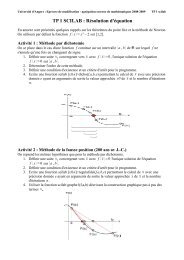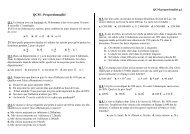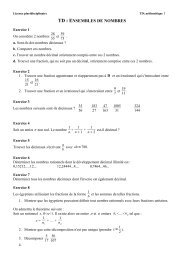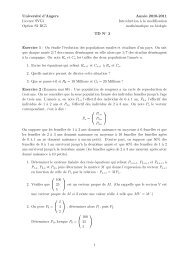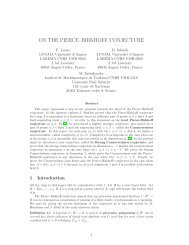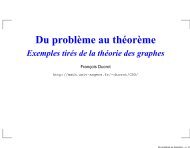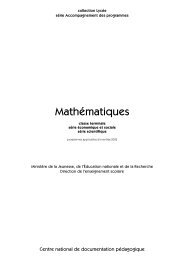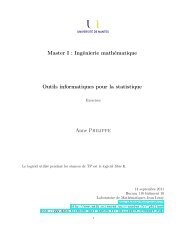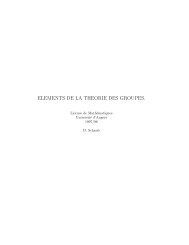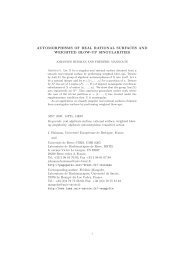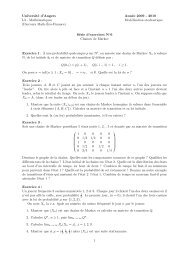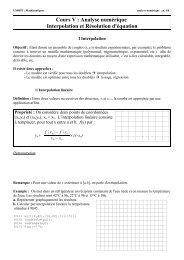Distortion control of conjugacies between quadratic polynomials
Distortion control of conjugacies between quadratic polynomials
Distortion control of conjugacies between quadratic polynomials
You also want an ePaper? Increase the reach of your titles
YUMPU automatically turns print PDFs into web optimized ePapers that Google loves.
SCIENCE CHINA<br />
Mathematics<br />
. ARTICLES . March 2010 Vol. 53 No. 3: 625–634<br />
doi: 10.1007/s11425-010-0041-7<br />
<strong>Distortion</strong> <strong>control</strong> <strong>of</strong> <strong>conjugacies</strong><br />
<strong>between</strong> <strong>quadratic</strong> <strong>polynomials</strong><br />
Dedicated to Pr<strong>of</strong>essor Yang Lo on the Occasion <strong>of</strong> his 70th Birthday<br />
CUI GuiZhen 1,∗ &TANLei 2<br />
1 Academy <strong>of</strong> Mathematics and Systems Science, Chinese Academy <strong>of</strong> Sciences, Beijing 100190, China;<br />
2 Laboratoire de Mathématiques, UMR du CNRS 6093, Université d’Angers, 2 bd. Lavoisier,<br />
49045 Angers cedex 01, France<br />
Email: gzcui@math.ac.cn, tanlei@math.univ-angers.fr<br />
Received September 25, 2009; accepted December 15, 2009<br />
Abstract We use a new type <strong>of</strong> distortion <strong>control</strong> <strong>of</strong> univalent functions to give an alternative pro<strong>of</strong> <strong>of</strong><br />
Douady-Hubbard’s ray-landing theorem for <strong>quadratic</strong> Misiurewicz <strong>polynomials</strong>. The univalent maps arise from<br />
Thurston’s iterated algorithm on perturbation <strong>of</strong> such <strong>polynomials</strong>.<br />
Keywords distortion, conjugacy, polynomial<br />
MSC(2000): 37F10, 30C35<br />
Citation: Cui G Z, Tan L. <strong>Distortion</strong> <strong>control</strong> <strong>of</strong> <strong>conjugacies</strong> <strong>between</strong> <strong>quadratic</strong> <strong>polynomials</strong>. Sci China Math, 2010,<br />
53(3): 625–634, doi: 10.1007/s11425-010-0041-7<br />
1 Introduction<br />
There are many quantities to measure the distance <strong>of</strong> a univalent function f from Möbius transformations<br />
besides <strong>of</strong> the C 0 -topology, for example, the Schwartz derivative Sf , or the nonlinearity f ′′ /f ′ .In[3],we<br />
introduce a new type <strong>of</strong> distortion <strong>control</strong> and prove an a priori bound <strong>of</strong> the distortion by applying this<br />
new type <strong>of</strong> distortion <strong>control</strong>. Another version <strong>of</strong> this a priori bound theorem is in particular used for<br />
complex dynamics. In this work, we use this theorem to give an alternative pro<strong>of</strong> <strong>of</strong> Douady-Hubbard’s<br />
ray-landing theorem for <strong>quadratic</strong> Misiurewicz <strong>polynomials</strong>.<br />
1.1 Definition <strong>of</strong> the distortion<br />
Let E ⊂ C be an open set and φ : E↩→ C be a univalent holomorphic function. Define<br />
D(φ, E) =sup{|mod(φ(A)) − mod(A)|},<br />
where A ⊂ C are annuli with finite moduli and ∂A ⊂ E, and by abuse <strong>of</strong> notation φ(A) denotes the<br />
annulus in C bounded by φ(∂A) (the map φ might not be defined on some points <strong>of</strong> A).<br />
∗ Corresponding author<br />
c○ Science China Press and Springer-Verlag Berlin Heidelberg 2010 math.scichina.com www.springerlink.com
626 CUI GuiZhen et al. Sci China Math March 2010 Vol. 53 No. 3<br />
1.2 A priori bound<br />
Let g be a geometrically finite rational map, i.e., the post-critical set Pg (the closure <strong>of</strong> the union <strong>of</strong> all<br />
the critical orbits) has a finite (or empty) accumulation set. Assume that the Fatou set <strong>of</strong> g is non-empty.<br />
Let X0 be the union <strong>of</strong> finitely many periodic cycles contained in the Julia set <strong>of</strong> g. It is known that every<br />
point in X0 is either parabolic or repelling. Set X1 = g−1 (X0)\X0, Xn+1 = g−n (X1) andX = <br />
n0 Xn.<br />
Now for each y ∈ X0, chooseUyasimply connected neighborhood <strong>of</strong> y satisfying the following properties:<br />
(1) These domains Uy are disjoint pairwise.<br />
(2) For each n 1andeachpointx∈Xnwith gn (x) =y ∈ X0, letUxbe the connected component <strong>of</strong><br />
g−n (Uy) containing x, and then the map gn : Ux \{x} →Uy \{y} is a covering (this implies that Ux ∩ Pg<br />
is either empty or equal to {x}).<br />
Denote by D the unit disc. For any point y ∈ X0, there is a Riemann mapping χ from Uy to D with<br />
χ(y) =0. SetUy(r) =χ−1 ({z : |z| 0 and a positive function C(r) defined on (0,r0) with<br />
C(r) → 0(as r → 0) such that for any n 0 and any univalent holomorphic map φ : Vn(r) ↩→ C,<br />
1.3 External rays<br />
D(φ, E) C(r).<br />
Now let us consider <strong>quadratic</strong> <strong>polynomials</strong> Qc(z) =z 2 + c. DenotebyKc the filled-in Julia set <strong>of</strong> Qc. For<br />
any c ∈ C, there exists a conformal map φc defined on a neighborhood <strong>of</strong> the infinity such that φc(∞) =∞,<br />
φc(z)/z → 1asz →∞and φc ◦ Qc(z) =(φc(z)) 2 .Themapφc is called the Böttcher coordinate <strong>of</strong> Qc at<br />
the infinity. If Kc is connected, then φc defines a Riemann mapping φc : C \ Kc → C \ D. Set<br />
Rc(θ) ={φ −1<br />
c (re 2πiθ ),r >1}.<br />
It is called the dynamical θ-ray for Qc. Even if Kc is disconnected, φc can be extended to a conformal<br />
map from a domain U whose boundary passes through the critical point zero to {z : |z| >r} for some<br />
constant r>1. In particular, the critical value c is contained in U.<br />
Recall that the Mandelbrot set is defined by M = {c : {Qn c (c)}n0 is bounded}. Equivalently, the point<br />
c is contained in M if and only if Kc is connected. Define Φ(c) =φc(c). It turns out that Φ : C\M → C\D<br />
is a conformal map with Φ(z)/z → 1asz →∞(refer to [4]). Set RM (θ) ={Φ−1 (re2πiθ ),r > 1}. It is<br />
called the parameter θ-ray.<br />
Theorem 1.2 (Pre-periodic external rays landing). Let c ∈ M be a parameter such that a strictly<br />
pre-periodic dynamical ray Rc(θ) lands at c. Then the parameter ray RM(θ) lands also at c.<br />
Such a polynomial Qc is called a Misiurewicz polynomial. This theorem is proved by Douady and<br />
Hubbard using a perturbation argument (refer to [5, p. 94]). We will reprove this theorem in this paper.<br />
Our approach is not known in the literature.<br />
2 Various types <strong>of</strong> distortions<br />
Let E ⊂ C be an open set and φ : E↩→ C be a univalent holomorphic function with D(φ, E) < ∞. The<br />
next lemma is easy to verify.
CUI GuiZhen et al. Sci China Math March 2010 Vol. 53 No. 3 627<br />
Lemma 2.1. (a) D(φ −1 ,φ(E)) = D(φ, E).<br />
(b) D(γ ◦ φ ◦ β,β −1 (E)) = D(φ, E), for any Möbius transformations β and γ <strong>of</strong> C.<br />
(c) D(φ, E1) D(φ, E) if E1 ⊂ E.<br />
(d) Assume that φn : E↩→ C is a sequence <strong>of</strong> univalent functions that converges locally uniformly to a<br />
univalent function φ. ThenD(φ, E) lim infn→∞ D(φn,E).<br />
2.1 Hyperbolic sup-norm <strong>of</strong> the Schwarzian derivative<br />
Let E ⊂ C be a hyperbolic open set. Denote by ρE(z) thePoincarédensity<strong>of</strong>E. Let φ : E↩→ C be a<br />
univalent function. The Schwarzian derivative <strong>of</strong> φ is defined by<br />
Sφ(z) = φ′′′ (z)<br />
φ ′ (z)<br />
− 3<br />
2<br />
′′ φ (z)<br />
φ ′ 2 .<br />
(z)<br />
Theorem 2.2. There is a universal constant C1 > 0 such that<br />
sup |Sφ(z)|ρE(z)<br />
z∈E<br />
−2 <br />
C1 D(φ, E). (1)<br />
To prove this theorem, we need the following lemmas. Refer to [3] for the pro<strong>of</strong> <strong>of</strong> the next lemma.<br />
Lemma 2.3. Let E ⊂ C be a hyperbolic open set with 0, 1, ∞∈E. Let φ : E↩→ C be a univalent<br />
function with 0, 1 and ∞ fixed. Then | log |φ ′ (z)|| 5πD(φ, E) for any point z ∈ E \{∞}.<br />
Lemma 2.4. There is a universal constant C2 > 0 such that<br />
sup |Sφ(z)|ρE(z)<br />
z∈E<br />
−2 C2. (2)<br />
This lemma is a generalization <strong>of</strong> the classical theorem <strong>of</strong> Kraus-Nehari (see below), and is first proved<br />
by Beardon and Gehring (see [1]) with the explicit constant C2 = 3. Here we give an independent pro<strong>of</strong><br />
using only the estimation <strong>of</strong> Poincaré densityandKöebe distortion theorem. The following results are<br />
known:<br />
(A) (refer to Theorem 2.1 in [6]) For any annulus A ⊂ C with mod(A) > 5log2/(2π), there exists an<br />
essential round annulus B ⊂ A (i.e., B separates the boundary components <strong>of</strong> A) such that<br />
mod(B) mod(A) − 5log2/(2π). (3)<br />
(B) (Kraus-Nehari theorem, refer to [6, p. 60]) Let D be a round disc in C with Poincaré densityρD<br />
and f : D↩→ C be a univalent function. Then<br />
sup |Sf (z)|ρ<br />
z∈D<br />
−2<br />
D (z) 3/2. (4)<br />
We say that two positive quantities ρ1 and ρ2 are comparable (denoted by ρ1 ∼ ρ2) if there is a universal<br />
constant C>1 such that 1/C < ρ1/ρ2
628 CUI GuiZhen et al. Sci China Math March 2010 Vol. 53 No. 3<br />
Pro<strong>of</strong>. Fix a constant r with 32
CUI GuiZhen et al. Sci China Math March 2010 Vol. 53 No. 3 629<br />
For any z ∈ E, choosez1 ∈ E such that ρE1(z) 2ρE(z) forE1 := E \{z1}. ChoosenowtwoMöbius<br />
transformations β and γ such that β(z1) =∞, β(z) =1,d(1,∂β(E1)) = 2 such that ψ := γ ◦ φ ◦ β −1<br />
fixes 0, 1and∞. SetG := β(E1). It is contained in C. Wehave<br />
|Sφ(z)|<br />
ρ 2 E<br />
|Sφ(z)|<br />
4 =4|Sψ(1)| . (8)<br />
(z) (z) (1)<br />
ρ 2 E1<br />
Since δ 0. Thus<br />
|ψ ′ (z) − ψ ′ (1)| C4δ<br />
for |z − 1| 1. Now we may apply the Cauchy integral formula to ψ ′ (z) onthecircle|z−1| =1<br />
to get that |ψ ′′ (1)|, |ψ ′′′ (1)| C5δ. Combining with ψ ′ |Sψ(1)|ρG(1)<br />
(1) ∈ Aδ, we get |Sψ(1)| C6δ. Therefore<br />
−2 C7δ(1 + | log δ|) 2 .<br />
Case B. mod(1,G) > | log δ|/π > 6log2/π.<br />
Let A be an essential round annulus in G whose core curve passes through the point 1 with modulus<br />
equal to mod(1,G), which is equal to log R/π for some constant R>0. Then<br />
So R>1/δ > 64. From Lemma 2.5, we have<br />
|Sψ(1)|<br />
ρ 2 G (1)<br />
Case 2<br />
ρ 2 G<br />
log R/π =mod(A) =mod(1,G) > | log δ|/π.<br />
12 |Sψ(1)| 2 log R<br />
∼ <br />
(1) π(R − 32)<br />
ρ 2 A<br />
Hence in both cases (9), (1) is proved.<br />
2.2 Controlling distortions <strong>of</strong> conjugations<br />
2<br />
<br />
2<br />
12 2 | log δ|<br />
2} and hence φc is univalent in E = {z : |z| > 8}∪{∞} by Koebe distortion<br />
theorem.<br />
Lemma 2.6. There is a universal constant C0 > 0, such that for any points c1,c2 ∈ C \ M with<br />
|Φ(ci)| 2(i =1, 2), we have<br />
<br />
|c1 − c2| C0 D(ψ, E),<br />
where ψ = φ−1 ◦ φc1.<br />
c2<br />
Pro<strong>of</strong>. Let φc(z) =z+b0+b1/z+··· be the expansion at the infinity. By the formula φc◦Qc(z) =φc(z) 2 ,<br />
one may check that b0 =0andb1 = c/2. Therefore ψ(z) has the expansion ψ(z) =z +(c1−c2)/(2z)+··· at the infinity.<br />
Let Ψ(z) =1/ψ(1/z) =z + a2z2 + a3z3 + ···. Using ψ(1/z)Ψ(z) ≡ 1 one obtains that a2 =0and<br />
a3 =(c2− c1)/2. This implies that SΨ(0) = 6a3 =3(c2−c1). Let ˜ρ(z)|dz| be the Poincaré metricon<br />
{z : |z| < 1/8}. Then˜ρ(0) = 16. Denote by ρ(z)|dz| the Poincaré metriconE. Then<br />
Sψ(z)<br />
lim<br />
z→∞ ρ2 SΨ(0)<br />
=<br />
(z)<br />
˜ρ 2 (0) = 3(c2 − c1)<br />
.<br />
256
630 CUI GuiZhen et al. Sci China Math March 2010 Vol. 53 No. 3<br />
Therefore by Theorem 2.2,<br />
3 Thurston algorithm<br />
|c1 − c2| = 256<br />
3<br />
|Sψ(z)|<br />
lim<br />
z→∞ ρ2 <br />
C0 D(ψ, E).<br />
(z)<br />
We will apply our distortion <strong>control</strong> to univalent maps arising naturally from the Thurston algorithm <strong>of</strong><br />
perturbations <strong>of</strong> rational maps.<br />
3.1 c-Equivalence <strong>between</strong> semi-rational maps<br />
Let F : C → C be a branched covering with deg F 2. Its post-critical PF is defined to be the closure <strong>of</strong><br />
the forward orbits <strong>of</strong> the critical points. Denote by P ′ F the accumulation set <strong>of</strong> PF . We say that F is a<br />
sub-hyperbolic semi-rational map if P ′ F is finite and either P ′ F = ∅ or F is holomorphic in a neighborhood<br />
<strong>of</strong> P ′ F and each cycle in P ′ F is either attracting or super-attracting.<br />
Two sub-hyperbolic semi-rational maps F1 and F2 are c-equivalent if there is a pair <strong>of</strong> homeomorphisms<br />
(φ0,φ1) <strong>of</strong>C such that (a) φ0 ◦ F1 = F2 ◦ φ1; (b) the two maps φ0 and φ1 are isotopic rel PF1; and(c)<br />
φ0 is holomorphic in a neighborhood <strong>of</strong> P ′ F1 (hence φ1 is also holomorphic and coincides with φ0 in a<br />
neighborhood <strong>of</strong> P ′ F1 ).<br />
3.2 Thurston algorithm<br />
Let F : C → C be a sub-hyperbolic semi-rational map with P ′ ′′<br />
F non-empty. Denote by P F the union <strong>of</strong><br />
P ′ F with all the periodic cycles in PF which meet critical points. Assume that F is holomorphic in a<br />
neighborhood <strong>of</strong> P ′′<br />
F . Pick three distinct points in PF . In this section, we say that a homeomorphism <strong>of</strong><br />
C is normalized if it fixes these three points.<br />
Assume that the sub-hyperbolic semi-rational map F is c-equivalent to a rational map f via a pair<br />
<strong>of</strong> normalized homeomorphisms (φ0,φ1). Since F is holomorphic in a neighborhood <strong>of</strong> P ′′<br />
F ,thereisa<br />
pair <strong>of</strong> normalized homeomorphisms (ξ0,ξ1) <strong>of</strong>C in the isotopy class <strong>of</strong> φ0 rel PF , such that they are<br />
holomorphic and coincide with each other in a neighborhood <strong>of</strong> P ′′<br />
F ,andξ0◦F = f ◦ ξ1. Furthermore,<br />
for n 2, there is a normalized homeomorphism ξn <strong>of</strong> C in the isotopy class <strong>of</strong> ξ0 rel PF such that<br />
ξn−1 ◦ F = f ◦ ξn and ξn coincides with ξ0 in a neighborhood <strong>of</strong> P ′′<br />
F .<br />
Lemma 3.1. The sequence {ξn} is uniformly convergent.<br />
This lemma is proved by Shishikura and Rees in the case that PF is finite (refer to [7]). One may check<br />
that their pro<strong>of</strong> works in the case that F is a sub-hyperbolic semi-rational map.<br />
Assume that η0 is a normalized homeomorphism <strong>of</strong> C such that η0 is holomorphic in a neighborhood<br />
<strong>of</strong> P ′′<br />
F . Then there is a unique normalized homeomorphism η1 <strong>of</strong> C such that f1 := η0 ◦ F ◦ η −1<br />
1 is<br />
holomorphic. Obviously, η1 is also holomorphic in a neighborhood <strong>of</strong> P ′′<br />
F . Recursively, there is a unique<br />
normalized homeomorphism ηn <strong>of</strong> C such that fn := ηn−1 ◦ F ◦ η−1 n is holomorphic. Then ηn is also<br />
holomorphic in a neighborhood <strong>of</strong> P ′′<br />
F . The sequence <strong>of</strong> rational maps {fn} is called a Thurston sequence<br />
<strong>of</strong> F .<br />
Theorem 3.2 (Convergence <strong>of</strong> the Thurston algorithm). Assumethesub-hyperbolicsemi-rational<br />
map F is c-equivalent to a rational map f via a pair <strong>of</strong> normalized homeomorphisms. Then the Thurston<br />
sequence {fn} converges uniformly to the rational map f. Moreover, the sequence {ηn} is also uniformly<br />
convergent.<br />
Pro<strong>of</strong>. By the definition we know that (a) φ0 ◦ F = f ◦ φ1; (b) the two maps φ0 and φ1 are isotopic<br />
. Since F is holomorphic in a<br />
rel PF ;and(c)bothφ0 and φ1 are holomorphic in a neighborhood <strong>of</strong> P ′ F<br />
neighborhood <strong>of</strong> P ′′<br />
F ,wemaymodifyφ0initshomotopy class such that both φ0 and φ1 are holomorphic<br />
and coincide in a neighborhood <strong>of</strong> P ′′<br />
F . As above, we have a sequence <strong>of</strong> normalized homeomorphisms
CUI GuiZhen et al. Sci China Math March 2010 Vol. 53 No. 3 631<br />
{φn}n1 <strong>of</strong> C in the isotopy class <strong>of</strong> φ0 rel PF , such that φn−1 ◦F = f ◦φn and φn = φ0 in a neighborhood<br />
<strong>of</strong> P ′′<br />
F .<br />
Set ψn = ηn ◦φ−1 n .Thenψnis holomorphic in a neighborhood <strong>of</strong> P ′′<br />
f . We may assume furthermore that<br />
ψ0 is a K-quasiconformal map <strong>of</strong> C by modifying φ0 in its isotopy class. Then ψn is also K-quasiconformal.<br />
It is easy to check that<br />
ψn−1 ◦ f = fn ◦ ψn.<br />
See the following diagram:<br />
··· → C<br />
f<br />
−→ C → ··· → C<br />
f<br />
−→ C<br />
f<br />
−→ C<br />
↑ φn ↑ φn−1 ↑ φ2 ↑ φ1 ↑ φ0<br />
··· → C<br />
F<br />
−→ C → ··· → C<br />
F<br />
−→ C<br />
F<br />
−→ C<br />
↓ ηn ↓ ηn−1 ↓ η2 ↓ η1 ↓ η0<br />
··· → C<br />
fn<br />
−→ C → ··· → C<br />
f2<br />
−→ C<br />
f1<br />
−→ C .<br />
Since ψ0 is a K-quasiconformal map <strong>of</strong> C and is holomorphic in a neighborhood W <strong>of</strong> P ′′<br />
f (we may choose<br />
W such that it is contained in the Fatou set <strong>of</strong> f and f −1 (W ) ⊃ W ), by the equation ψn−1 ◦ f = fn ◦ ψn,<br />
we see that ψn is also a K-quasiconformal map <strong>of</strong> C and holomorphic in f −n (W ). Therefore there is<br />
a subsequence <strong>of</strong> {ψn} which converges uniformly to a limit quasiconformal map ψ <strong>of</strong> C. Moreover, ψ<br />
is holomorphic in ∪f −n (W ) which is the Fatou set. Thus ψ is holomorphic on C since the measure <strong>of</strong><br />
the Julia set <strong>of</strong> f is zero. Combining with the normalization condition, we know that ψ is the identity.<br />
Therefore the entire sequence {ψn} converges uniformly to the identity. It follows that the Thurston<br />
sequence {fn} converges uniformly to the rational map f .<br />
Because ηn = ψn ◦ φn, from Lemma 3.1, we know that the sequence {φn}, and therefore the sequence<br />
{ηn} is uniformly convergent.<br />
4 Misiurewicz-hyperbolic deformation<br />
We now begin to prove Theorem 1.2. Recall that φc is the Böttcher coordinate <strong>of</strong> the <strong>quadratic</strong> polynomial<br />
Qc(z) =z 2 + c at infinity. For c ∈ M, themapφc defines a Riemann representation φc : C \ Kc → C \ D.<br />
The dynamical θ-ray is defined by<br />
Rc(θ) ={φ −1<br />
c (re 2πiθ ),r >1}.<br />
For the Mandelbrot set M, the Douady-Hubbard Riemann representation Φ : C \ M → C \ D is defined<br />
by Φ(c) =φc(c). The parameter θ-ray is defined by<br />
RM (θ) ={Φ −1 (re 2πiθ ),r >1}.<br />
Let c ∈ M be a parameter such that a strictly pre-periodic dynamical ray Rc(θ) lands at c. Wewant<br />
to show that the parameter ray RM (θ) lands also at c.<br />
Set c(t) =Φ −1 (te 2πiθ )fort>1. In other words, we will prove that c(t) → c as t → 1. Denote by<br />
U = {z : |φc(z)| >t}, U1 = {z : |φ c(t)(z)| >t}, V = {z : |φc(z)| >t 2 } and V1 = {z : |φ c(t)(z)| >t 2 }.<br />
Then they are Jordan domains. Both Qc : U→Vand Q c(t) : U1 →V1 are proper. The critical value c(t)<br />
<strong>of</strong> Q c(t) lies on the boundary <strong>of</strong> U1 and the post-critical set <strong>of</strong> Q c(t) is contained in the closure <strong>of</strong> U1. Set<br />
ψ = φ −1<br />
c(t) ◦ φc. Thenψ(U) =U1 and ψ(V) =V1. Moreover, the following diagram commutes:<br />
U<br />
ψ<br />
−→ U1<br />
Qc ↓ ↓ Q c(t)<br />
V<br />
ψ<br />
−→ V1.
632 CUI GuiZhen et al. Sci China Math March 2010 Vol. 53 No. 3<br />
Figure 1 Perturbation F <strong>of</strong> Qc<br />
Step 1. Construction <strong>of</strong> a topological perturbation F <strong>of</strong> Qc.<br />
Denote by z(t) =φ−1 c (te2πiθ ). Then z(t) =ψ−1 (c(t)) ∈ ∂U. Letγt = φ−1 c ({re2πiθ , 1 r t}). It is a<br />
closed arc connecting the point c with the point z(t), whose interior is contained in Rc(θ) ∩ (C \U).<br />
Let W be a Jordan domain in C \V such that γt ⊂ W . Choose ζ : C → C a homeomorphism that<br />
is the identity outside W ,withζ(c) =z(t). Set F := ζ ◦ Qc. Then the critical points <strong>of</strong> F are {0, ∞}<br />
with F (0) = z(t). Therefore F n (z(t)) = Qn c (z(t)) →∞as n →∞. So PF = {z(t),F(z(t)),...}∪{∞}<br />
and P ′ ′′<br />
F = P F = {∞}. AsFis holomorphic in a neighborhood <strong>of</strong> the infinity which is a super-attracting<br />
fixed point <strong>of</strong> F , we conclude that F is a sub-hyperbolic semi-rational map.<br />
Lemma 4.1. Thesub-hyperbolicsemi-rationalmapFis c-equivalent to Qc(t). Pro<strong>of</strong>. Let ψ0 be a homeomorphism <strong>of</strong> C such that ψ0|U = ψ|U. Then ψ0(PF )=PQ and the<br />
c(t)<br />
following diagram commutes:<br />
U<br />
ψ0<br />
−→ U1<br />
F ↓ ↓ Q c(t)<br />
V<br />
ψ0<br />
−→ V1.<br />
The homeomorphism ψ0 : C \V →C \V1 maps the critical value z(t) <strong>of</strong>F to the critical value c(t) <strong>of</strong><br />
Q c(t). Thus there is a unique lift ψ1 : C \U →C \U1 <strong>of</strong> ψ0, such that ψ1|∂U = ψ|∂U. Obviously, as a lift<br />
<strong>of</strong> ψ0, themapψ1 satisfies that ψ1(0) = 0, and the following diagram commutes:<br />
C \U<br />
ψ1<br />
−→ C \U1<br />
F ↓ ↓ Q c(t)<br />
C \V<br />
ψ0<br />
−→ C \V1.<br />
Now extend the map ψ1 to a homeomorphism <strong>of</strong> C by ψ1|U = ψ|U. Then ψ0 ◦ F = Qc(t) ◦ ψ1. Since<br />
ψ0|U = ψ1|U = ψ|U and PF ⊂ U, by Alexander trick, any homeomorphism <strong>of</strong> a topological disc which is<br />
the identity on the boundary is isotopic to the identity rel the boundary. We know that ψ1 and ψ0 are<br />
isotopic rel PF . This proves that F and Qc(t) are c-equivalent.<br />
Step 2. Application <strong>of</strong> the Thurston algorithm to F .<br />
Let η0 be a Möbius transformation <strong>of</strong> C such that it is normalized by mapping the triple (0,F2 (z(t)), ∞)<br />
to the triple (0,Q2 c(t) (c(t)), ∞). As in Section 3, there is a unique homeomorphism η1 <strong>of</strong> C with the same<br />
normalization, such that f1 := η0 ◦ F ◦ η −1<br />
1 is holomorphic on the Riemann sphere C. Since F is<br />
holomorphic except on F −1 (W )=Q−1 c (W ), we see that η1 is holomorphic except on F −1 (W ).
CUI GuiZhen et al. Sci China Math March 2010 Vol. 53 No. 3 633<br />
Recursively, there is a unique homeomorphism ηn <strong>of</strong> C with the same normalization, such that fn :=<br />
ηn−1 ◦ F ◦ η−1 n is holomorphic on C. Moreoverηnis holomorphic except on n k=1 F −k (W ). Noticing that<br />
F = Qc except on F −1 (W )=Q−1 c (W ), we have<br />
n<br />
F −k (W )=<br />
k=1<br />
n<br />
k=1<br />
Q −k<br />
c (W ).<br />
By Theorem 3.2 and Lemma 4.1, we see that the sequence {fn} converges uniformly to the <strong>quadratic</strong><br />
polynomial Qc(t) and the sequence {ηn} uniformly converges to a continuous map η <strong>of</strong> C. Notethatηnis holomorphic in V and is normalized by mapping the triple (0,F2 (z(t)), ∞) to the triple (0,Q2 c(t) (c(t)), ∞)<br />
for all n 0. Thus η is univalent on V and mapping the pair (F 2 (z(t)), ∞) to the pair (Q2 c(t) (c(t)), ∞)<br />
(note that F 2 (z(t)) = Q2 c (z(t)) ∈V). In particular, η−1 ◦ Qc(t) ◦ η = F = Qc on V. Therefore η|V = ψ|V.<br />
This is because that the holomorphic conjugation <strong>between</strong> two super-attracting fixed points <strong>of</strong> degree<br />
two is unique.<br />
Pro<strong>of</strong><strong>of</strong>Theorem1.2. The critical point zero is pre-periodic for Qc. SetX0to be the unique periodic<br />
cycle in PQc. We define Xk and X as in Section 1.<br />
Note that E := {z : |z| > 8}∪{∞}is compactly contained in V for t ∈ (1, √ 2). For each y ∈ X0 we<br />
choose a simply connected neighborhood Uy such that Uy ∩ E = ∅ and Uy \{y} is disjoint from PQc.<br />
Define Ux and Ux(r) for any point x ∈ X and any constant r 0and<br />
a positive function C(r) defined on r ∈ (0,r0) withC(r) → 0(asr→0) such that for any t>1with<br />
r(t) 1 such that r(t) 0 such that<br />
<br />
|c − c(t)| C0 D(η, E) C0 C(r(t)).<br />
Therefore |c − c(t)| →0ast → 1sinceC(r) → 0asr → 0andr(t) → 0ast → 1. Now the theorem is<br />
proved.<br />
Acknowledgements The first author was supported by National Natural Science Foundation <strong>of</strong> China (Grant<br />
Nos. 10831004, 10721061), and by Hua Loo-Keng Key Laboratory <strong>of</strong> Mathematics, Chinese Academy <strong>of</strong> Sciences.<br />
The second author was supported by the EU Research Training Network on Conformal Structures and Dynamics.<br />
The authors cordially thank the referees for their careful reading and helpful comments.<br />
References<br />
1 Beardon A, Gehring F W. Schwarzian derivatives, the Poincare metric and the kernel function. Comment Math Helv,<br />
1980, 55: 50–64<br />
2 Beardon A, Pommerenke C. The Poincaré metric <strong>of</strong> plane domains. J London Math Soc, 1978, 18: 475–483
634 CUI GuiZhen et al. Sci China Math March 2010 Vol. 53 No. 3<br />
3 Cui G Z, Tan L. A priori bound for the distortion <strong>of</strong> univalent functions. Preprint<br />
4 Douady A, Hubbard J H. Etude dynamique des polynômes complexes (première partie). Publications Mathématiqus<br />
d’Orsay, 84-02, 1984<br />
5 Lehto O. Univalent Functions and Teichmüller Spaces. Berlin: Springer-Verlag, 1987<br />
6 McMullen C. Complex Dynamics and Renormalizations. Annals <strong>of</strong> Mathematics Studies 135. Princeton: Princeton<br />
University Press, 1994<br />
7 Shishikura M. On a theorem <strong>of</strong> Mary Rees for matings <strong>of</strong> <strong>polynomials</strong>. In: Tan L, ed. The Mandelbrot Set, Theme<br />
and Variations. LMS Lecture Note Series 274. Cambridge: Cambridge University Press, 2000, 289–305



